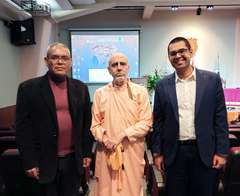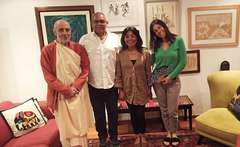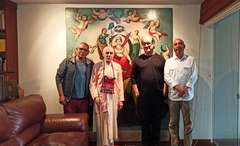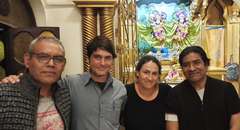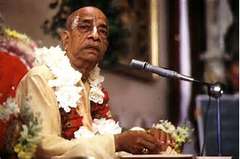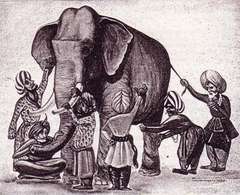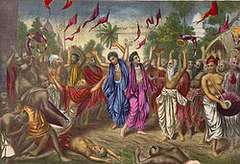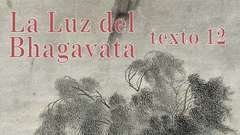GOVARDHANA!! / SOLARIS ROAD TO INDEXATION
Hare Krishna respected Gurudeva.
Please accept my humble obeisances.
All glories to Srila Prabhupada !!
All glories to Hanumatpresaka Swami !!
We have started the process of indexing SOLARIS in the international sphere of academic and scientific publications. This implies editing two numbers a year (minimum) one in June and another one in December. In addition, the articles are going to be evaluated to guarantee contents of high quality. Our research area revolves around the development of the human spirit cultivation. This indexing allows SOLARIS to be listed in a worldwide query database. This will make the magazine have a higher and higher impact factor.
SOLARIS indexing offers several advantages:
• Much greater world visibility.
• Access to the magazine from various places in the world (in fact, we have started in LATINDEX, which is a regional online information system for magazines in Latin America, the Caribbean, Spain and Portugal).
• Use by the academic community. To measure the use that the community has given to an article, it is used an indicator called IMPACT FACTOR that relates to the number of citations that the article receives from other uses.
• Stimulates the location of peers, which allows academics from other parts of the world who are investigating the same or similar topics to commit to our projects.
• It is achieved a greater exchange about our research at national and international level, and with this, greater progress and depth is also achieved related to the study and knowledge of human development and spirituality, in general, and to the cultivation of the human spirit, in particular.
PROFESSORS WHO HAVE COMMITTED, SO FAR, TO WRITE IN SOLARIS No. 5
Ramon Mujica / Patron of the Cervantes Institute of Spain
Brijesh Rawat / National Rehabilitation University - Lucknow, India
Itzel Diego Barrier. / ITESM - México
Eduardo Gastelumendi / PUCP – Perú (not yet confirmed)
Bernardo Nante / USAL – Argentina (not yet confirmed)
Héctor Béjar / UNMSM - Perú
Paula Miranda / PUCP-Chile
Denis Kolobov / Tchaikovsky Conservatory - Russia
Miguel Polo / UNMSM - Perú
Verónica Castillo / PUCP – Perú
Rosario Godensi / Montessori - perú
The mothers Lalita-gopi, Govinda pramodini and Gopi-Radha will make the reviews of the books in this issue and mother Purnamasi, of Spain, would make a text of her experience as a devotee, mother and educator, (it can be a narration or a fiction)
On Sunday, March 1 I inform you about the academic sankirtana here and Ramavami (also, as SOLARIS, it relates to RAMANAVAMI)
Good news: The CEAS of San Marcos and the Jesuit University said yes to the Declaration of participation in THE EDUCATION AND THE SACRED 2020, JAY NIMAI-NITAI
That is all for now.
Hare Krishna dear Gurudeva, his insignificant servant, Abhiram Thakur a Das
-0-0-0-
HpS - ASA --- Very nice! What is the Calendar for article? When will you have synopsis of the articles? Have you sent a suggestion of differene themes for the magazine?
SOLARIS RUMBO A LA INDEXACION
Hare Krishna respetado Gurudeva, por favor acepte mis humildes reverencias
¡Todas las Glorias a Srila Prabhupada!!
¡Todas las Glorias a Hanumatpresaka Swami!!
Hemos empezado el proceso de indexar SOLARIS en el circulo internacional de las publicaciones académicas y científicas, esto implica editar dos números al año (es lo mínimo) uno en junio y otro en diciembre, además ahora los artículos van a ser evaluados para avalar contenidos de alta calidad. Nuestra área de investigación gira en torno al desarrollo del cultivo del espíritu humano. Esta indexación permite que SOLARIS este listada en una base de datos de consulta a nivel mundial, esto hará que la revista tenga un mayor y más elevado factor de impacto
La indexación de SOLARIS nos ofrece varias ventajas:
· Mucha mayor visibilidad mundial.
· Acceso a la revista desde diversos sitios del mundo (de hecho, hemos empezado en LATINDEX, que es un sistema regional de información en línea para revistas de América Latina, el Caribe, España y Portugal).
· Uso por parte de la comunidad académica. Para medir el uso que la comunidad le ha dado a un artículo, se suele utilizar un indicador que se relaciona con la cantidad de citas que recibe el artículo por parte de otros usuarios, esto se denomina FACTOR DE IMPACTO,
· Estimula la localización de los pares, lo cual permite que académicos de otras partes del mundo que estén investigando el mismo tema o temas similares se comprometan con nuestros proyectos.
· Se consigue un mayor intercambio a nivel nacional e internacional sobre nuestras investigaciones y con ello se logra mayor avance y profundidad en el estudio y conocimiento del desarrollo humano y espiritualidad, en general y del cultivo del espíritu humano, en particular.
Articulistas de SOLARIS No. 5
Ramon Mujica / Patrono del Instituto Cervantes de España
Brijesh Rawat / National Rehabilitation University - Lucknow, India
Itzel Barrera De Diego. / ITESM – México
Eduardo Gastelumendi / PUCP – Perú
Bernardo Nante / USAL – Argentina
Héctor Béjar / UNMSM – Perú
Paula Miranda / PUCP-Chile
Denis Kolobov / Conservatorio Tchaikovsky – Rusia
Miguel Polo / UNMSM – Perú
Verónica Castillo / PUCP – Perú
Las madres Lalita-gopi, Govinda pramodini y Gopi-Radha van a hacer las reseñas de los libros en este número y la madre Purnamasi de España haría un textimonio de su experiencia como devota, madre y educadora, (puede ser una narración o una ficción)
El domingo 1 de marzo le informo sobre el sankirtana académico aquí y Ramavami (también, como SOLARIS, se relacionara con RAMANAVAMI)
Buenas noticias: El CEAS de San Marcos y la Universidad Jesuita dijeron sí a la Declaración de participación en LA EDUCACIÓN Y EL SAGRADO 2020. JAY NIMAI-NITAI
Eso es todo por ahora, Hare Krishna querido Gurudeva, su insignificante sirviente, Abhiram Thakur das.


